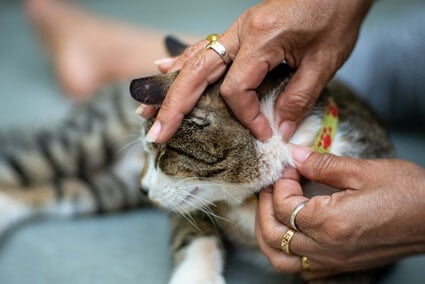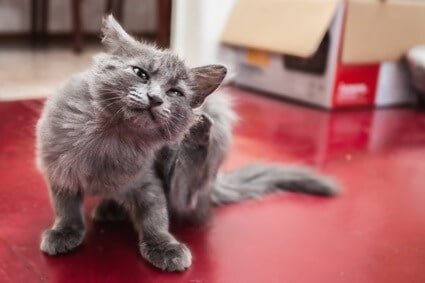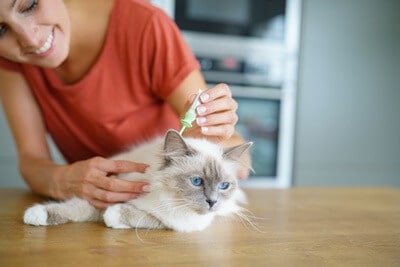More owners are switching to natural cat flea treatment alternatives. While various home remedies are used on cats, some don’t work, and others should be avoided because they’re toxic.
To get rid of cat fleas naturally, treatment options include cedar chips, oregano, apple cider vinegar (ACV) and chamomile. Cats dislike the smell of these spray solutions. Also, feeding your cat a natural, raw-meat diet can improve your cat’s defenses against fleas.
Garlic, neem oil, and citronella are commonly suggested as natural parasite repellents, but they’re poisonous to cats. Diatomaceous earth may kill fleas on your carpets and upholstery, but it’s a dust that can cause respiratory irritation if inhaled by cats.
Natural Flea Remedies for Cats
The table below has info on the best and worst natural treatments for cat fleas. It explains how it works and why a remedy should be avoided:
| Cedar Chips and Cedar Oil: | Smell repels fleas |
| Oregano Oil: | Insecticidal properties |
| Apple Cider Vinegar: | Flea-repellent |
| Chamomile Tea: | Mild-flea repellent |
| BARF Diet: | Improves immunity |
How Do Fleas Spread in Cats?
Fleas don’t spread from one cat to another.
Once a flea lands on a cat, it’ll feed on its blood for the remainder of its life. Ingesting blood allows a female flea to become fertile and lay eggs (about 50 a day).
Flea larvae will burrow into dark spaces in your home, such as carpets, cracks in hardwood floors, and furniture. The flea larvae (baby fleas) will wait for your cat to walk by and find a new home.
Once they hop onto your cat, their lifecycle commences.
Cat Flea Home Remedies That Work
Fleas are hard-shelled, fast, and highly adaptable parasitic insects that can survive famine conditions. So, an adult flea can survive with just one blood meal for up to 2 months.
Natural flea remedies for cats work via repetition, so the treatment must be repeated each day until there aren’t any fleas left on your cat’s body.
However, any topical flea treatment must be combined with home treatments, such as daily vacuuming, to remove adult fleas, eggs, and larvae from the cat and its environment.
Let’s explore some natural cat flea home remedies:
Cedar Chips
Fleas despise the smell of cedar, and many cats aren’t fond of it either.
However, spreading some cedar chips outside in your yard and around your cat’s bedding can deter fleas from entering your cat’s living environment.
Apply a cedarwood oil spray (made with a few drops of cedarwood oil and water) to your cat’s fur.
Never use undiluted cedarwood oil as it can cause respiratory irritation when used in high concentrations. It is safe and non-toxic for cats when diluted, even with regular usage.
For cedar oil sprays to be effective, they must be used daily until all fleas are gone.
Oregano Oil
Oregano oil gets its flea-removing qualities from a natural compound called carvacrol. Carvacrol is a monoterpenoid phenol that gives oregano its warm and pungent smell.
According to Pest Management Science, two components in oregano oil, carvacrol, and thymol, could be used as natural alternatives to chemical insecticides.
Mix 1 teaspoon of oregano oil with 3 teaspoons of olive oil and work the solution into flea-infested areas, such as the tail, neck, stomach, and around the ears.

Apple Cider Vinegar (ACV)
ACV has an acidic pH of 2-3, so it should never be used undiluted on a cat’s skin. Apple cider vinegar cannot kill fleas, but it’s a proven flea deterrent.
To make the solution, mix 2 parts of water with 1 part apple cider vinegar. Spraying a diluted apple cider vinegar solution on your cat’s fur will cause the fleas to leave your cat’s body.
Following each treatment, you’ll want to clean all floors, upholstery, and linens.
Some cats drink diluted apple cider vinegar to treat intestinal parasites.
Chamomile Tea
Chamomile tea is a gentle flea cleanser that doubles as a calming agent for itchy skin. Once the tea has steeped, allow it to cool off before applying it to your cat’s coat.
Chamomile tea isn’t as potent as the above treatments but can be combined with other natural flea treatments due to its soothing properties.
The BARF Diet
Fleas are less likely to target healthy hosts. Therefore, optimizing your cat’s immunity and overall health is a proven way of strengthening its defenses against fleas.
The BARF diet is a way to tackle cat fleas from the inside out. Years of research have proven that the best diet for cats is a biologically appropriate raw food (BARF) diet.
Cats are obligate carnivores, consuming only raw meat. The BARF diet consists of raw meat and added supplements with no grains or dairy. A raw meat diet is a long-term solution against fleas that should be combined with other flea-eliminating treatments.
An alternative to a raw food diet is opting for commercial pet food containing no grains, artificial additives, preservatives, unnamed meat meals, by-products, or bone meal.
Choose a brand that’s high in protein and low in carbohydrates.
Natural Cat Flea Treatments To Avoid
The flea treatments in this table are remedies for parasites that don’t work:
| Garlic: | Toxic when ingested |
| Citronella: | Skin/eye irritants and toxic when ingested |
| Pennyroyal Oil: | Causes fatal liver damage |
| Brewer’s Yeast: | Ineffective treatment |
| Diatomaceous Earth: | Respiratory and eye irritation |
| Neem Oil: | Toxic substance |
Garlic
Garlic, when used internally and externally, is a popular insect repellent. Some suggest adding garlic to your cat’s food as it makes bloodmeal less appealing.
However, there’s no evidence that garlic’s effective against fleas. In fact, garlic is poisonous for dogs in high doses, and cats are even more vulnerable to garlic’s toxic effects.
According to studies in Interdisciplinary Toxicology and Frontiers in Veterinary Science, accidental ingestion of garlic is a common cause of food poisoning in cats.
Citronella
Citronella oil is a popular natural insect repellent. Because humans use it to keep away mosquitos, some users may consider using citronella to treat fleas on cats.
However, citronella’s side effects outweigh its potency against fleas as it’s a skin and eye irritant. Also, it can be toxic if inhaled or ingested.

Pennyroyal Oil
Derived from the pennyroyal herb, pennyroyal oil has a history of being used as a flea deterrent.
However, even at recommended dosages, pennyroyal oil can have toxic effects when used for cats and dogs. Topical application may cause fatal liver damage.
Brewer’s Yeast
There’s no evidence to suggest that adding brewer’s yeast to your cat’s food can control fleas.
The School of Veterinary Medicine found no difference in flea counts in animals that received active yeast and those given inactive yeast.
Diatomaceous Earth
Diatomaceous earth is a natural, silica-containing flour-like powder made of fossilized remains of diatoms, which are aquatic organisms.
Diatomaceous earth can be used as a flea-control substance in two ways:
- Applying it to your cat’s fur (very harmful)
- Applying it to your carpets (potentially harmful)
When applied to your cat’s fur, diatomaceous earth is a powdery substance that can cause respiratory issues, scarring of the lungs, and eye irritation.
Neem Oil
Neem oil is a natural insect repellent used against parasitic insects, such as fleas and mosquitos.
Some owners may have had success with neem oil in treating fleas on dogs. However, cats are more sensitive to neem oil and may experience side effects.
Although neem oil isn’t listed as a toxic plant for cats by the ASPCA, it can lead to adverse reactions, such as excessive salivation. To be safe, it should be avoided.


Thank you, Richard, for all this wonderful information!
Do you have any information on the safety of oregano essential oil on cats? I’d read it was good for Malassezia fungus in their ears, but then read in another article it can cause weakness and even coma if ingested or absorbed through the skin. I just don’t know what to do. My senior cat (18) has a horrible problem with this fungus in his ears (not confirmed but appears as such), skin and nails. It appears to be due to an antibiotic treatment received years ago and now his immune system is out of wack, despite his raw diet and not getting shots.
Thank you for any help you can provide. I don’t trust the vets anymore.
Thank you Richard! I am determined to avoid toxic flea collars and treatments for my dog and cats. You pointed out the positive and negative aspects of many natural remedies, that are very helpful in understanding what works and why. I will try some of these suggestions!